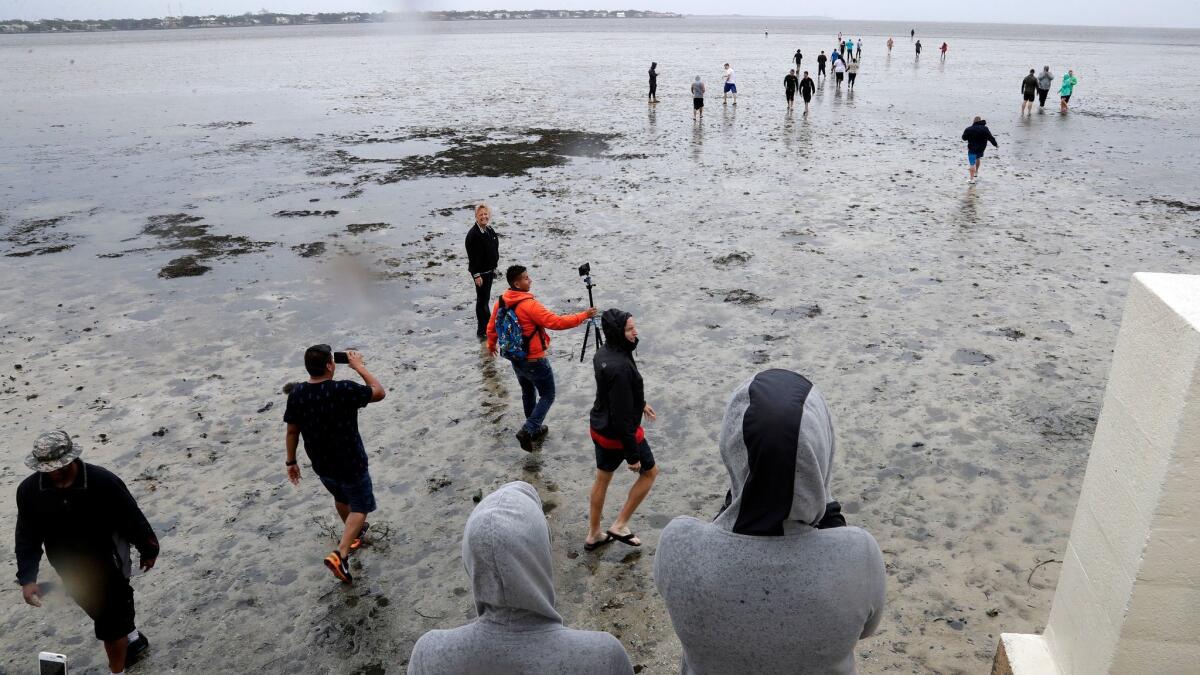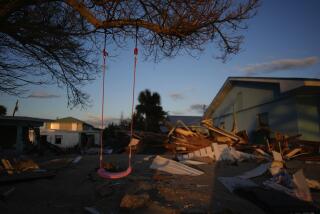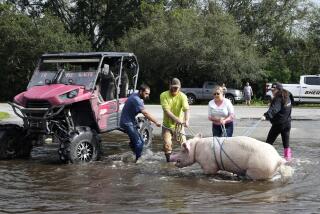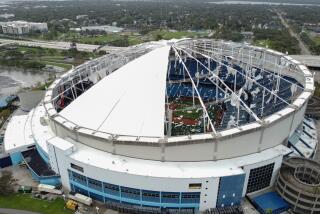Tampa hasn’t had a big hurricane in 96 years. That’s about to change

- Share via
Reporting from MIAMI — It has been nearly a century since the Tampa Bay area was in the bull’s-eye of a major hurricane. That changed when Hurricane Irma veered north Sunday and began barreling toward the twin-cities metropolis of Tampa and St. Peterburg and the western coast of the Florida peninsula.
Winds from Irma, which was downgraded Sunday to a Category 2 storm, started battering the region in the evening. And the National Hurricane Center warned that Tampa Bay, home to about 3 million Floridians, could see storm surges of between 2 and 4 feet.
But a sudden turn to the northeast spared Tampa the worst of Irma’s savagery.
Earlier in the day, Gov. Rick Scott had said that flooding was expected along the entire west coast of Florida — “and this has increased to 15 feet of impact above ground level in southwest Florida.”.
Such conditions would have been a recipe for a disaster similar to one that struck the Tampa Bay-St. Petersburg metro area on Oct. 25, 1921.
According to the National Weather Service, the so-called Tarpon Springs Hurricane, which was not officially named, made landfall as a powerful Category 3 storm just north of Tarpon Springs, a city on central Florida’s Gulf Coast.
A storm surge estimated at 11 feet destroyed substantial portions of the sea wall and inundated areas in Bayshore and Tarpon Springs.
Many vessels were smashed against the docks by waves, and the hurricane wreaked havoc on structures in the bay area, especially at Edgewater Park, the Hendry and Knight Channel and Palmetto Beach where many buildings were destroyed, the National Weather Service in the Tampa Bay area reported in a 2011 video presentation posted on its Facebook page.
“Waves from the bay were almost breaking in the streets of Ybor City,” Tampa’s historic Latin Quarter, it said.
At least eight people were confirmed killed during the storm, most of them from drowning as a storm surge inundated areas along the shore, the weather service said.
The Tampa Bay area, then home to about 10,000 people, had not seen such a destructive storm since 1848, when the so-called Great Gale was reported to have destroyed many of the structures that were then standing. But few records are available about that storm.
Florida’s southwest was pummeled again in 2004 when Hurricane Charley wreaked havoc in Charlotte County and in 2005 when Hurricane Wilma slammed into Collier County, whose county seat is East Naples.
On its website, the city of Tampa describes itself as “an amazing place to live, work, and visit,” but there is an acknowledgment that because of its coastal location, topography and large population, the city is “significantly vulnerable to a wide array of hazards, including hurricanes, floods, tornadoes, and sinkholes.”
Many parts of downtown Tampa are new and built close to the bay, which is gradually being pulled into the Gulf of Mexico.
On Sunday, residents took to social media to post photos and video taken from drones showing that Irma had pulled water from Tampa Bay area waterways, including Hillsborough Bay, which was covered in mud, according to a view from nearby Bayshore Boulevard.
Paul Dellegatto, a meteorologist for Fox 13 in Tampa, told the network that “strong east winds from the storm were pushing water south out of the bays and bayous.”
Storm surges were expected to refill the waterways and could produce heavy flooding. The region is prone to flooding even during average rain events, and it was unclear how the storm drainage systems, which are old and in need of replacement, would fare.
St. Petersburg was instructed last year by the Florida Department of Environmental Protection to replace the city’s drainage system after heavy flooding from Hurricane Hermine, a smaller Category 1 storm. But officials say it’s going to take years to do that, and the process has barely begun.
The National Weather Service warned in its video presentation on the 1921 storm that, given the scale of urban development in the Tampa Bay area over the years, the impact of another major hurricane event “could be catastrophic.”
Many residents of Tampa were taking no chances. By Wednesday, stores had begun to empty of water, bread and other staples. Lines had formed at gas stations, and many people were just waiting for official word to get out.
Orders for mandatory evacuations in the Tampa Bay area began to arrive Thursday for low-lying beach communities and for people living in mobile homes and were extended to other areas as the storm’s trajectory changed. In Pinellas County, where St. Petersburg is located, about 260,000 were eventually advised to leave.
Many Florida attractions, such as Busch Gardens in Tampa, were closed and flamingos and other animals were shepherded to shelters.
Many residents, who had not expected their city to land in Irma’s crosshairs, expressed alarm on social media.
“I honestly don’t know what’s scarier - the fact #Tampa hasn’t been hit directly by a hurricane since 1921 or that #hurricanirma is the,” one Twitter user wrote without completing her thought. “I was born and raised in #TampaBay have never called anywhere else home. I’m scared for my city, my friends and all the people of Tampa.”
Special correspondent Neuhaus reported from Miami and Times staff writer Simmons from Los Angeles.
Follow me @AMSimmons1 on Twitter.
UPDATES:
9:21 p.m.: This article was updated with the National Hurricane Center downgrading the forecast effects in the Tampa Bay area.
This article was originally published at 7:45 p.m.
More to Read
Sign up for Essential California
The most important California stories and recommendations in your inbox every morning.
You may occasionally receive promotional content from the Los Angeles Times.











